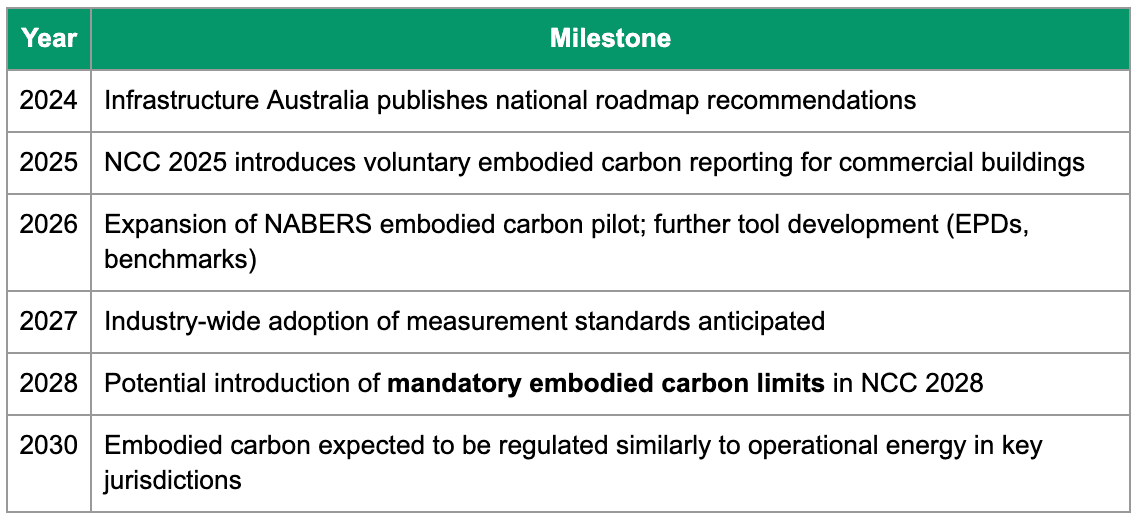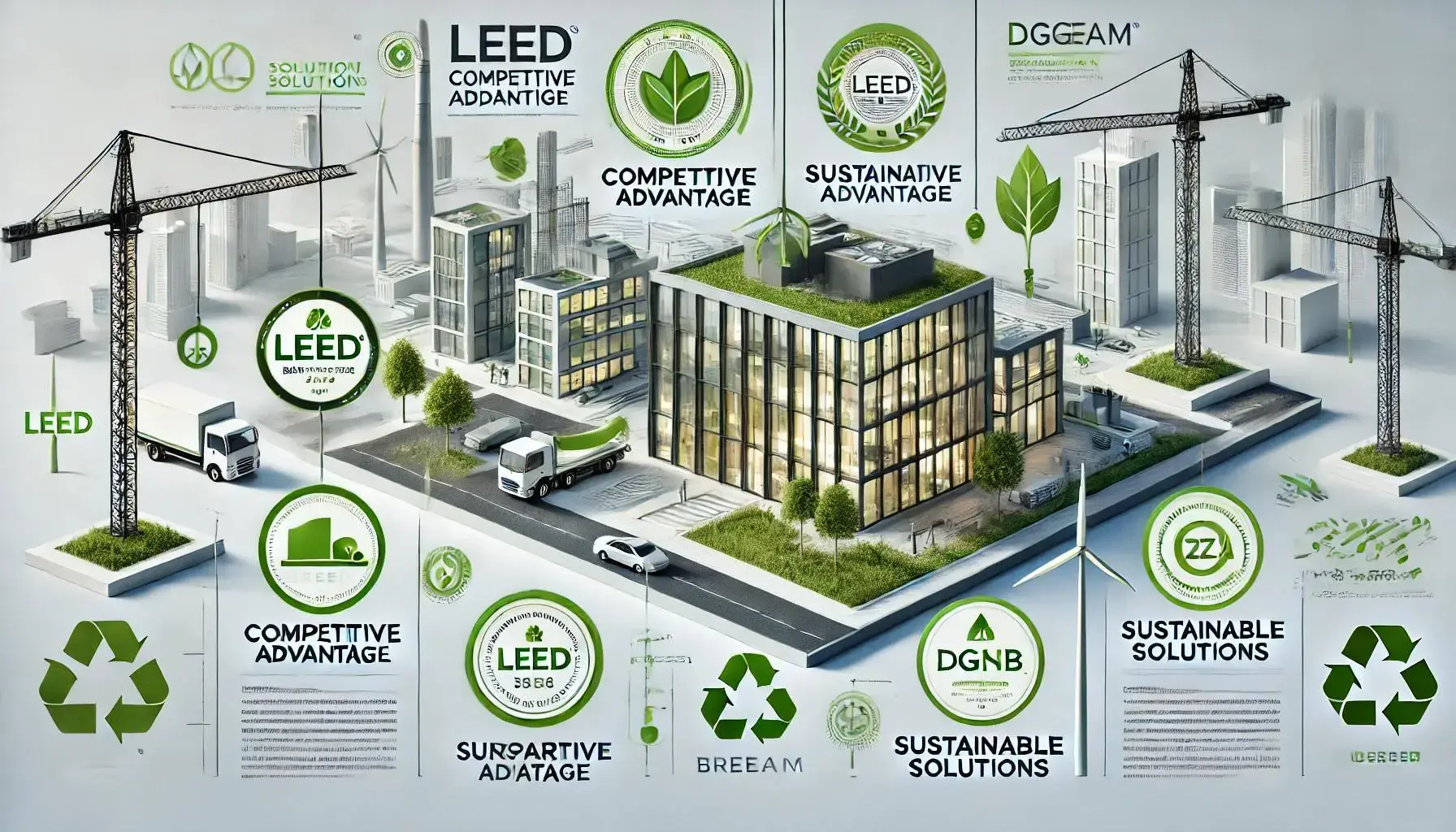Australia’s built environment is responsible for nearly one-third of the nation’s carbon emissions, with embodied carbon (emissions from materials and construction) contributing a growing share. While operational energy is increasingly regulated, embodied emissions have only recently begun to receive policy attention. This article provides an overview of where Australia stands at both federal and state levels, how our efforts compare globally, and how embodied carbon fits within Australia’s broader net zero transition strategy.
Current Policy Landscape
Federal Progress
Australia is laying the groundwork at the national level:
NCC 2025 (Voluntary Pathway): The next update to the National Construction Code will include a voluntary option to report embodied carbon in commercial buildings—an early step towards future regulation.
Infrastructure Australia (2024 Report): Recommends a national approach including standardised measurement methods, a materials emissions database, and stronger procurement frameworks. The report notes that a 23% reduction in upfront emissions is achievable by 2026–27.
ASBEC Roadmap: The Australian Sustainable Built Environment Council is spearheading a policy roadmap to cut upfront emissions, aiming for alignment between industry and government.
State and Territory-Level Action
While embodied carbon is not yet widely regulated at the state level, several jurisdictions are beginning to integrate it into planning, procurement, and building guidelines—especially in New South Wales, Victoria, and Queensland.
New South Wales
Sustainable Buildings SEPP (2022): Introduced by the Department of Planning and Environment, this planning instrument applies to both residential and non-residential development. While focused mainly on operational performance (energy and water), it opens the door for future scope expansion into embodied emissions. Several local councils are already pushing further.
Green Star Requirements in Government Projects: NSW Government projects often require minimum Green Star ratings (4–6 Star), which include criteria for upfront embodied carbon. The Sustainable Procurement Policy promotes low-emission materials for state-delivered infrastructure.
Victoria
Circular Economy Policy (“Recycling Victoria”): Although not targeted specifically at embodied carbon, this whole-of-government policy supports the reuse of construction materials and aims to reduce the embodied impacts of waste-intensive building practices.
Big Build Projects: Major infrastructure projects (e.g. Metro Tunnel, North East Link) include embodied carbon assessments and targets in delivery contracts, often tied to IS Rating System requirements.
Queensland
Building Future Schools Fund & Vertical Schools Program: The Department of Education has incorporated embodied carbon considerations in procurement for select school infrastructure projects, piloting low-carbon materials and tracking.
Sustainable Procurement Policy: The Queensland Procurement Policy encourages whole-of-life value and environmental performance, supporting the uptake of products with lower embodied emissions, though not yet mandatory.
Brisbane City Council: Brisbane’s development incentives favour sustainability certifications like Green Star and NABERS, which include embodied carbon modules, particularly in the city centre and for large developments.
How Australia Compares Globally
European Union: Setting the Bar
Whole-of-Life Carbon Assessments are mandated under the revised Energy Performance of Buildings Directive (EPBD).
Product-Level Transparency: The Construction Products Regulation (CPR) requires environmental product declarations (EPDs) for construction materials.
Outcome: The EU leads globally, with enforceable, harmonised standards across all phases of a building’s life cycle.
United States: Patchy but Progressing
Federal Blueprint: The Department of Energy’s 2023 strategy targets a 65% emissions cut from buildings by 2035 and 90% by 2050, incorporating both operational and embodied emissions.
Local Leadership: Areas like Marin County (California) mandate low-embodied-carbon materials for new buildings, but there's no national policy framework.
Australia: Laying the Foundations
Australia’s approach is early-stage and largely voluntary, with efforts focused on building the measurement infrastructure and aligning stakeholders. Compared with the EU’s mandates, Australia’s policy has strong potential for growth.
Embodied Carbon in Australia’s Net Zero Trajectory
Australia has committed to net zero emissions by 2050. With embodied carbon estimated to contribute around 10% of national emissions (as of 2023), addressing it will be essential to hitting this target.
Key developments:
Measurement Tools Are Emerging: National EPDs and carbon factor databases are in development, such as NABERS and LCMH Embodied Carbon Database.
Industry Engagement Is Growing: Voluntary benchmarking schemes and rating tools (e.g. NABERS embodied carbon pilot) are helping define best practice.
NCC 2028 May Introduce Mandatory Limits, following the voluntary framework laid out in NCC 2025.

What Can We Expect?
Mandatory Reporting on embodied carbon likely within 3–5 years.
Low-Carbon Procurement policies to be embedded in public infrastructure delivery.
Centralised Databases to support benchmarking, certification and compliance (e.g. EPD registries and life cycle assessment tools).
Capacity Building across the design and construction supply chain to ensure readiness.
Australia is on the cusp of transitioning from voluntary approaches to regulatory frameworks for embodied carbon. The policy signals are there, the tools are under way, and the market is beginning to respond. To keep pace globally and meet our climate obligations, we need coordination, ambition and follow-through.



